891 Search Results for core vocabulary
August 12, 2013
by Carole Zangari -
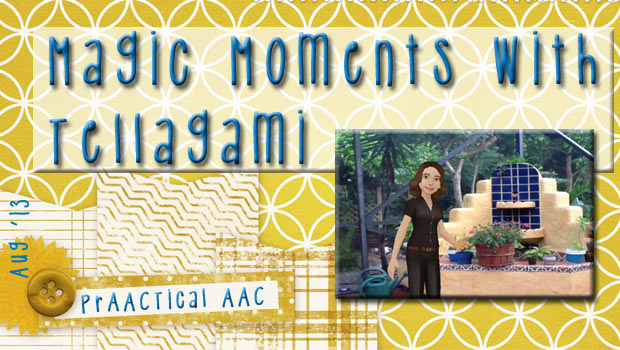
Looking for ways to engage older learners with age appropriate materials? Searching for fresh ideas for AAC and language practice? Tellagami (“tell-uh-gah-mee”) is a free iOS app that allows you to create short animations, save them to your device, post to Facebook, and share them by email, SMS text, or Twitter. Best part about it, in this busy SLP’s opinion? Super easy to learn and use! The animations are called ‘Gami’s’ and are short and fun to make. The app has a good amount of flexibility and you are only limited by your imagination. Here are some ideas for putting it to use in your AAC work. 1. Choice making: The AAC learner can work collaboratively with a peer to create a Gami. In doing so, he/she can make selections of things like the gender of the character, hair, clothes, and the background. 2. Peer interactions: Many of our AAC... [Read More...]
August 10, 2013
by Robin Parker -
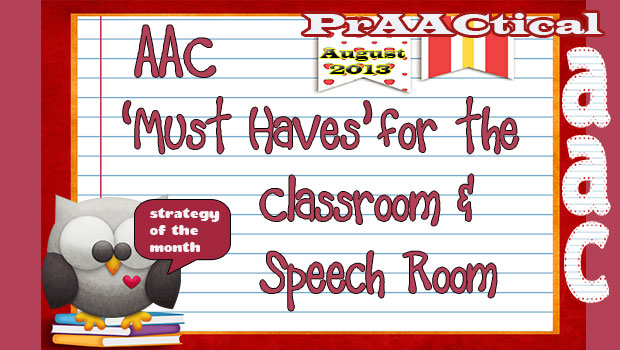
As we were getting ready for back to school and thinking about ‘must haves’, it quickly became apparent that it is not so easy to narrow it down. And the ‘must haves’ would definitely vary depending upon type of class, students, and even school. Based on a wide variety of differences, we organized a wide variety of choices to explore (we apologize in advance if we got carried away but…). Choose what you need, bookmark what you may need later and let us know your ‘must haves’ for a classroom and speech room AAC collaborative approach. We will create an ongoing list. Get Started Before School Starts Do these 10 Things to Get Started with AAC if you are new to an AAC student or classroom Provide AAC Support in the Classroom. Support teachers and educators with tips from Jane Farrall, & learn about AAC in the Classroom by Joan... [Read More...]
August 7, 2013
by Robin Parker -
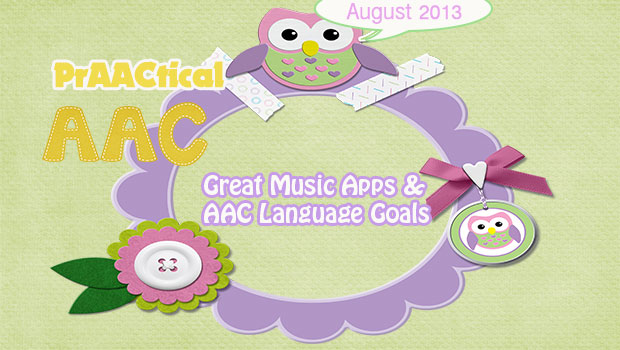
We love music, we love apps, we love great language opportunities and with these apps we can combine all these loves. These awesome music apps were selected because they have great choice making and commenting opportunities. You can use no tech, low tech, or an extra high-tech device to make choices and comment while you play with the app. Core words work great for choice making and commenting. Whenever I play or sing, my kids love to say “stop that” or “don’t do that pleeeeease”. When they play, I love to use aided language input (ALI) to say “good”, “more”, “again”, “love it” . We play the music “fast” and “slow”. We “find” our “favorite one”. We all like to say “let’s play with that one” or “let’s do it together”. The possibilities are really endless (and that is one of the reasons we love core words). These apps sound... [Read More...]
August 2, 2013
by Robin Parker -
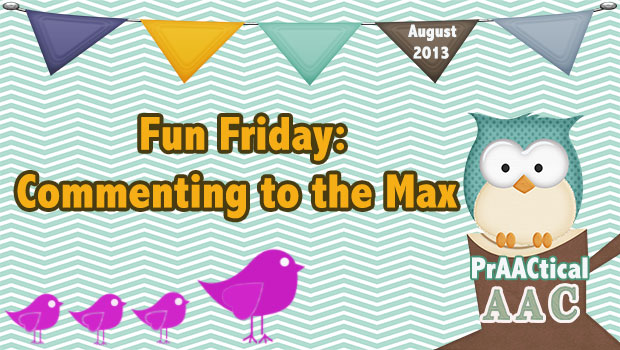
Commenting is for everyone, even if they are beginning communicators and even if they need to learn. If you are teaching commenting to a learner who does not yet have this communication function, there has to be ‘buy in’ or interest through another communication function that is already known. So, for a learner who can ask for things they want or say ‘no’ to things they ‘don’t want’, you may need to form routines where they ask for something, comment, then can ask (and receive) again. Once the routine is established, you can add some more teaching and language facilitation strategies. We have written about commenting before but when we saw this cool photo on Facebook, we just had to mention commenting again. Commenting to the Max Go Ape! 10 Commenting Communication Temptations More Ways to Teach Commenting Make it Meaningful to the Learner – Just talking about things may... [Read More...]
July 27, 2013
by Carole Zangari -
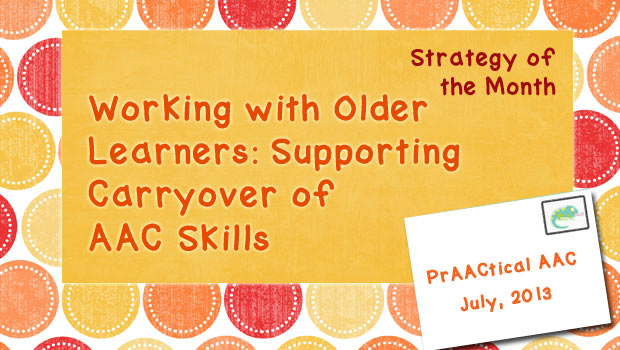
One of the biggest challenges that SLPs face is how to help the communicator use new skills outside the therapy room. Whether the client is someone who stutters, has voice problems, or any other speech-language difficulty, the question is the same: How can we get the client to use skills that were learned and practiced in a therapeutic situation to use those same skills at home, in school, and in the community? It’s an issue with all learners, but for adolescents and adults, we seem to be playing ‘catch up’ all the time. Plus, they are encountering greater numbers of less familiar communication partners and have to fend for themselves more often, making skill generalization even more of a critical topic. Much has been written about problems of generalization by using loose training, and varying the instructional setting, partners, instructions, prompts, and materials. In our way of thinking, it starts... [Read More...]
July 23, 2013
by Robin Parker -
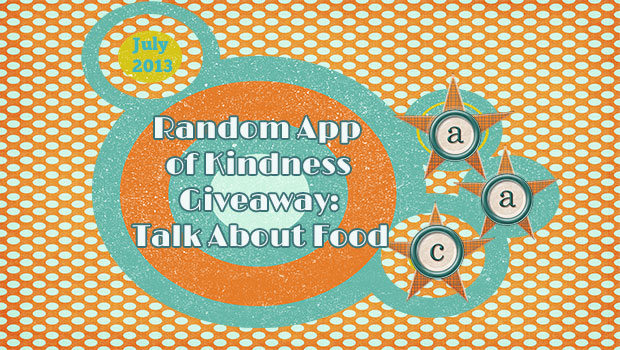
It’s a summer prAACtical Random App of Kindness giveaway! Thanks to the generosity of Hump Software (& Celeste Helling), we have 3 codes for Talk About Food. Talk about Food has been developed to target vocabulary building and communication skills. It has been designed specifically for children with low vision as well as those who are having difficulty with language development, or just starting to learn and use words through AAC. Pictures of food and food categories are high contrast to spark interest and visual attention. Then, the focus is talking about food (hence the app name). The communication emphasis is on core word vocabulary (Yay!) and building sentences. There are many great features & access settings and you can easily hide and show vocabulary for customization. The Giveaway starts now and ends on Saturday July 27th at 11:59 pm. We will select 3 winners for the Talk About Food App.... [Read More...]
July 4, 2013
by Robin Parker -
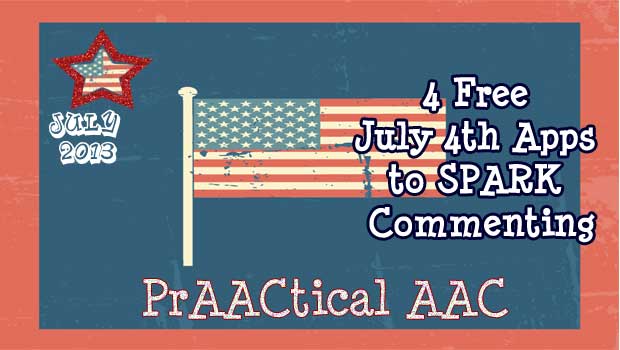
Check out these 4 free apps that can help SPARK commenting. They are great fun that will inspire commenting but can also help with core (and fringe) vocabulary as well as with being familiar with July 4th festivities. By engaging with these apps in an interactive manner, there is not the noise and confusion of the day. The apps become a good tool for familiarizing and preparing the learner for July 4th. Celebrate 4th of July, Independence Day of the United States , with sparkling fireworks (by Auryn Apps) Free – Just shake or touch the iPad and beautiful fireworks get triggered. The are really beautiful which are opportunities to comment again and again (“wow”, “beautiful”, “so cool”, “look colors”, etc.). Each firework reveals images that relate to Independence Day. This app is a gift from Auryn Apps which is a generous and dedicated developer for July 4th and throughout the year.... [Read More...]
June 5, 2013
by Robin Parker -

Strategy of The Month Communication Boards: Colorful Considerations Communication Boards Can Be Used For…. A Lot I Made A Communication Board: Bow What Join Together: Core & Fringe Vocabulary Fresh Look AAC in the Classroom with Joan Bruno Friendship Skills for Children Who Use AAC with Dr. Erinn Finke Top 5 Switches for People With ALS by Amy Roman AAC & Dementia with Dr. Melanie Fried Oken AAC for Children Who Have Rett Syndrome with Dr. Theresa Bartolotta AACtual TherapyHow We Do It Essential Tricks for Supporting AAC in Schools, Part 2 PrAACtical Look: AAC at Dynamic Therapy Associates by Vicki Clarke A Framework for Success Getting Started in the Exciting World of Communication & AAC with Marlene Cummings AAC Myth Buster Wrap-Up PrAActical Thinking It’s PrAACtically Better Hearing & Speech Month 30 Posts You May Have Missed for Autism Awareness Month It’s PrAACtically Mother’s Day- 5 Activities that Support... [Read More...]
June 4, 2013
by Carole Zangari -
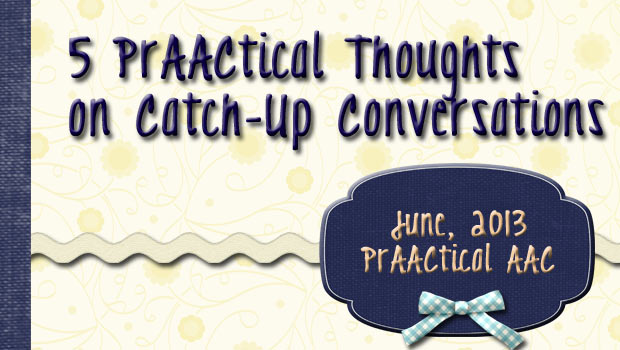
One of the things SLPs frequently do at the start of their therapy sessions is have some casual conversations with their clients to catch up on what happened since their last visit. Whether it is an elementary school student with ASD, a teenager with cerebral palsy, or an older adult with aphasia, we engage in polite conversation to find out what they’ve been up to and perhaps share a bit about our own experiences. Here are some thoughts on making those ‘catch-up conversations’ work from a prAACtical perspective. 1. Possible goal areas: initiate conversation; maintain dialogue on an established topic; redirect conversation to a new topic; respond to non-obligatory communication opportunities; use temporal terms in multi-word utterances; convey a personal narrative with a clear beginning, middle, and end; use regular past tense verbs; ask partner-focused questions 2. Core language targets: it, we, they, do/did, have/had, was/were, not It was (not);... [Read More...]
May 26, 2013
by Carole Zangari -
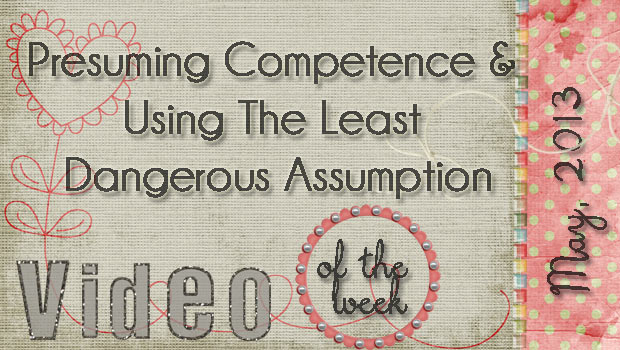
One of our core language posts from last month referred to the criterion of the least dangerous assumption (Donellan, 1984). This week we’re pleased to be able to expand on that topic and share a video by Dr. Cheryl Jorgensen, a former project director at the Institute on Disability at the University of New Hampshire. As we near the end of a school year in the US and begin IEPs that will direct the activities for the next academic year, we’re all reminded how critical it is to set high but attainable goals. Sometimes, that means making the least dangerous assumption. You can view the video here. Donnellan, A. (1984). The criterion of the least dangerous assumption. Behavior Disorders, 9, 2, 141-150.









